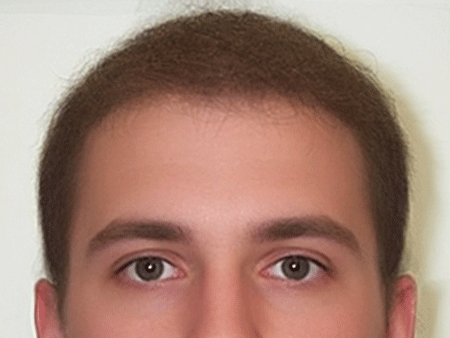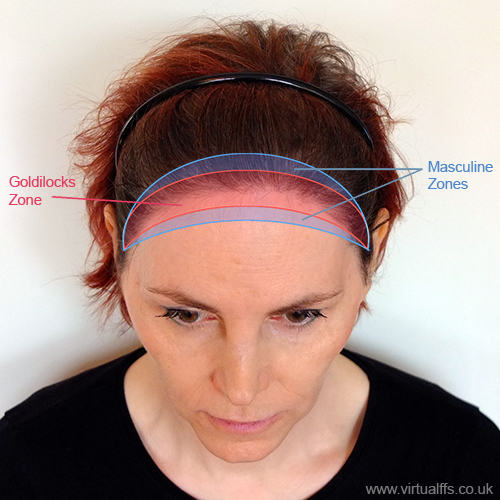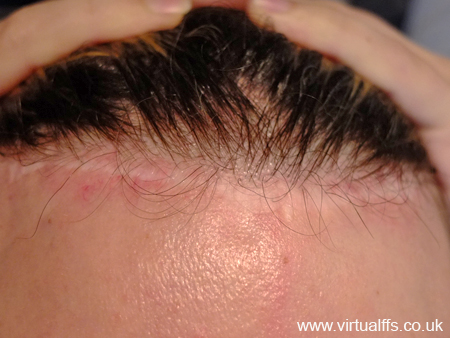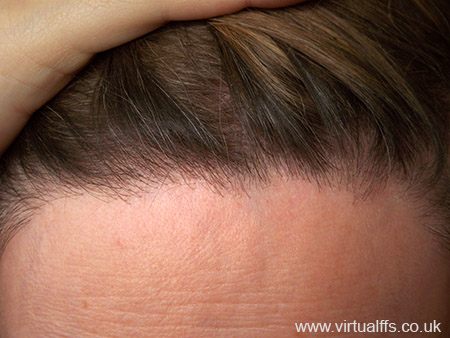Hair and Hairline
Gender Differences
Many FFS surgeons and patients believe that on average, women have lower hairlines in the middle than men but this is not actually true. In fact, women have higher hairlines in the middle than men (you can read more about this towards the bottom of the page under "Misconceptions").
Of course men often get male-pattern baldness which can raise the hairline, and some men have naturally high hairlines. But the average male hairline, when balding is not present, is lower in the middle than the average female hairline.
If you look at the overall shape of the hairline, masculine hairlines tend to have an M shape or square Π shape, while feminine hairlines tend to be rounded like this: Ո.
Many women also have what I call "ghost corners". These are hairline corners like you see in the masculine Π and M shapes, but they are filled with fine downy hair rather than being naked. And there is another, rarer feminine hairline shape that is particularly common in South Asia that I call the "omega" hairline which comes forwards into little peaks in the corners. It has this shape Ω
Here is an animation created from averaged male and female faces showing the lower hairline at the front in the male:

You will see the same masculine/feminine hairline height differences in other examples of averaged faces on the internet despite some surgeons still insisting that female hairlines are lower in the middle. A good example is the BeautyCheck website. You can also see more of them in part 3 of my thesis on facial feminisation here.
To sum up: most trans women do not need to bring the whole hairline forwards, they only need to fill the corners.
The Goldilocks Zone
Despite the fact that male hairlines are a little lower, perhaps the most important thing about hairline height is that overall, it's not particularly important in gender recognition, and the range of hairline heights that work for both women and men forms quite a wide zone. I call this gender-neutral zone the "Goldilocks Zone". Here it is:

Basically, any hairline height within the Goldilocks zone works fine for most people, without having any notable effect on masculinity or femininity.
As you can see in the picture, the area above the Goldilocks zone, and the area below it are both masculine. The reason for this is simple: the area above it is masculine because very high hairlines are typical of men with male pattern baldness, while the area below it is masculine because male hairlines are, on average lower than female hairlines, and if you go very low, you are
getting into a strongly masculine range that is usually only seen on men.
The main thing to take from the Goldilocks zone is that
you rarely have to change the hairline height in feminisation.
This is important because it means that even if you believe that male hairlines are on average higher than female hairlines, your own hairline will probably still be in the goldilocks zone and you therefore probably don't need a scalp advance to lower it. This in turn means you can avoid the hairline scar issue caused by a scalp advance.
Surgical Options for Filling the Corners:
1. Scalp Advance:
Some surgeons try to fix the corners with a scalp advance which involves cutting along the hairline and stretching the scalp down in various ways to try to fill the gaps. I have seen little evidence that this is an effective technique - only a limited amount of corner closure can be achieved; it leaves a scar along the hairline and it also tends to put a lot of tension on the scars. This tension can cause the scars to widen and be more noticeable.
2. Hair Transplants:
Hair transplants look more natural than a scalp advance and you don't end up with a scar along the hairline. They would normally be done a few months after any forehead surgery.
Facial Team have developed a way of doing them at the same time as forehead surgery by harvesting a strip of scalp from the incision they use to do forehead surgery. They are then able
to use the hair follicles from that strip to fill the corners. See below for more on hair transplants and how they work.
In the minority of trans women who have naturally high hairlines or who have baldness affecting the hairline height, it might also be appropriate to lower the whole hairline, but again, it is usually best to do this with transplants because you avoid putting a visible scar along the hairline (see "scalp advance" below).
Surgical Options for Lowering the Hairline:
1: Scalp Advance:
In a scalp advance a strip of skin is removed from in front of the hairline, the scalp is lifted away from the skull and pulled forward to fill the gap. There is a limit to how far the scalp can be moved in one go - an inch or an inch and a half (2 to 3 cm) is typical so two or more separate scalp advances several months apart may be required to achieve the desired result. If the surgeon is also doing work on the forehead bones, they can do it through the same incision as the scalp advance.
However, There is always a visible scar from a scalp advance. How visible it is will partly depend on luck, partly on the skill of the surgeon and partly on your own tendency to scar. Some patients with a faint scar feel that it is not a problem, but for many others, it is clearly visible and they are conscious of it.
Here is a photo of a scalp advance scar that someone was kind enough to let me use. This one is a little worse than average but you can clearly see the problem:

2: Hair Transplants:
You can also lower the hairline by using transplants. This leaves a much more natural-looking hairline with no visible scar. The transplants would normally be done a few months after any forehead surgery. See below for more on hair transplants.
Some people combine both procedures - they start with a scalp advance during their forehead surgery, then a few months later, they finish the hairline and fill the corners with transplants. However, it can still be difficult to hide the scar this way because transplants don't take as well in scar tissue, and the scar is only a little way into the new hairline meaning you may still be able to see it through the transplants.
I had 2 sessions of hair transplants with Dr Damkerng Pathomvanich in Bangkok, Thailand. Here is a close-up of my hairline so you can see how they look about 4 years on. The front centimetre or so is all transplants:

About Hair Transplants:
Hair transplantation involves taking hair follicles from one part of your scalp and transplanting them into another part where hair is thin or missing. In the past, the technique gave poor results because large clumps of hair (sometimes called "plugs") were transplanted giving an effect a little like doll's hair. Modern techniques though are excellent and involve transplanting a single follicle at a time. The result looks natural when done by a skilled surgeon.
Modern transplants fall into 2 categories:
FUT:
This stands for "Follicular Unit Transplant". This is where a strip of scalp is taken, usually from the back of the head. The hair follicles are then dissected out before being transplanted into the problem areas. My transplants in the picture above were FUT.
FUE:
This stands for "Follicular Unit Extraction". This is where individual hair follicles are removed one at a time from various places around the scalp and transplanted into the problem areas.
With FUT you can transplant more hairs in a single session, the hair follicles are less likely to be damaged and it is generally cheaper. However, there is a linear scar at the back of the head which could show if you had very short hair.
With FUE the recovery time is shorter, there is no linear scar, and you don't need such a big team of people working on you. But, it is more expensive, you can't transplant as much hair in one go, and there is a greater risk of damaging the follicles.
Each hair follicle contains between 1 and 4 hairs. The transplanted hairs fall out soon after transplantation but the hair follicle is alive and about 3 to 4 months after the surgery, the hairs start to grow again.
There is a limit to how densely the hair can be packed in at one time so more than one procedure may be needed to achieve a good density.
Some Questions:
Does a scalp advance cause permanent numbness?
There will certainly be some temporary numbness, but this should disappear over the course of a few months.
In some cases, there are permanent areas where the sensation is not as
sensitive as it was before, but you don't generally notice these areas in
your everyday life unless you actually feel for them.
Will my hairline be raised if I have the incision for forehead surgery over the top of my head?
Yes, but only slightly, and as women tend to have slightly higher hairlines in the middle than men, this can actually be mildly feminising. And you also have the advantage of the scar being hidden.
In addition, your eyebrows also rise with forehead surgery so the gap
between your eyebrows and hairline doesn't change much.
Should a scalp advance always be avoided?
There may be cases where a scalp advance is a good idea, but I don't
generally come across them.
Can a scalp expander help?
A scalp expander is an inflatable balloon that is placed under the scalp and gradually inflated over a few weeks so that the scalp will stretch further. This is quite an invasive technique and can be painful. There is also an infection risk because you have an open wound for the duration that you have the expander in.
I do not know of any advantage to using an expander (except perhaps that it is cheaper) and I do not recommend the technique.
My Surgeon uses a special incision that makes the scar invisible:
It is possible to angle the cut so that the hairs will grow through the scar tissue to some extent. This
is called a "trichophytic closure" and it helps to hide the scar.
Misconceptions About Hairline Height:
So why do so many people believe men's hairlines are higher overall? I suspect that it mainly comes down to an optical illusion that is caused by the shape of the hairline rather than the height of the hairline itself. You can read all about that on this page of my Common Misconceptions page of my website here but I can sum up my approach to hairlines with this simple rule:
The shape of the hairline is more important than the height!